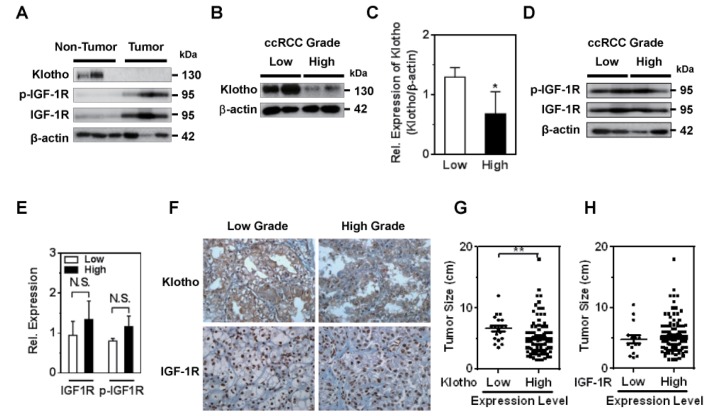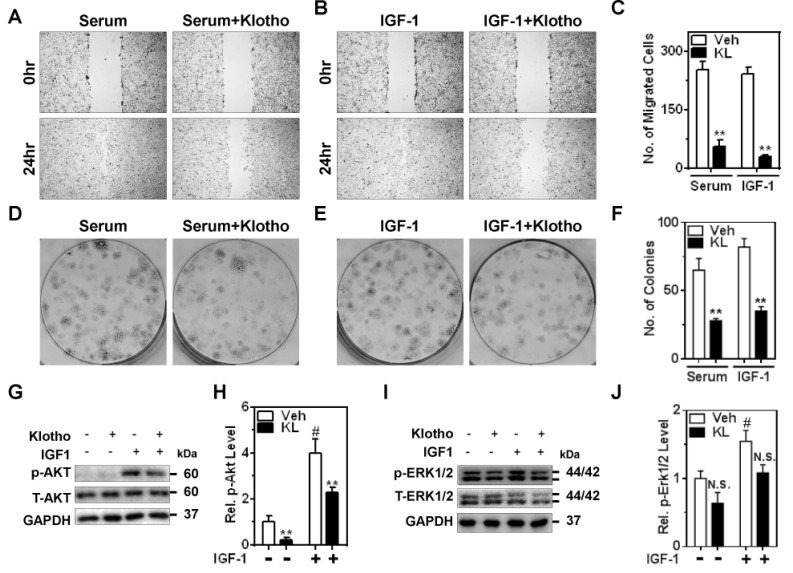Korean J Physiol Pharmacol.
2016 May;20(3):297-304. 10.4196/kjpp.2016.20.3.297.
Klotho plays a critical role in clear cell renal cell carcinoma progression and clinical outcome
- Affiliations
-
- 1Department of Physiology and Global Medical Science, Yonsei University Wonju College of Medicine, Wonju 26426, Korea. skcha@yonsei.ac.kr
- 2Department of Pathology, Yonsei University Wonju College of Medicine, Wonju 26426, Korea. eomm@yonsei.ac.kr
- 3Department of Urology, Yonsei University Wonju College of Medicine, Wonju 26426, Korea.
- 4Institute of Lifestyle Medicine, Yonsei University Wonju College of Medicine, Wonju 26426, Korea.
- KMID: 2285602
- DOI: http://doi.org/10.4196/kjpp.2016.20.3.297
Abstract
- Klotho functions as a tumor suppressor predominantly expressed in renal tubular cells, the origin of clear cell renal cell carcinoma (ccRCC). Altered expression and/or activity of growth factor receptor have been implicated in ccRCC development. Although Klotho suppresses a tumor progression through growth factor receptor signaling including insulin-like growth factor-1 receptor (IGF-1R), the role of Klotho acting on IGF-1R in ccRCC and its clinical relevance remains obscure. Here, we show that Klotho is favorable prognostic factor for ccRCC and exerts tumor suppressive role for ccRCC through inhibiting IGF-1R signaling. Our data shows the following key findings. First, in tumor tissues, the level of Klotho and IGF-1R expression are low or high, respectively, compared to that of adjacent non-neoplastic parenchyma. Second, the Klotho expression is clearly low in higher grade of ccRCC and is closely associated with clinical outcomes in tumor progression. Third, Klotho suppresses IGF-1-stimulated cell proliferation and migration by inhibiting PI3K/Akt pathway. These results provide compelling evidence supporting that Klotho acting on IGF-1R signaling functions as tumor suppressor in ccRCC and suggest that Klotho is a potential carcinostatis substance for ccRCC.
MeSH Terms
Figure
Reference
-
1. Kuro-o M, Matsumura Y, Aizawa H, Kawaguchi H, Suga T, Utsugi T, Ohyama Y, Kurabayashi M, Kaname T, Kume E, Iwasaki H, Iida A, Shiraki-Iida T, Nishikawa S, Nagai R, Nabeshima YI. Mutation of the mouse klotho gene leads to a syndrome resembling ageing. Nature. 1997; 390:45–51. PMID: 9363890.
Article2. Kurosu H, Yamamoto M, Clark JD, Pastor JV, Nandi A, Gurnani P, McGuinness OP, Chikuda H, Yamaguchi M, Kawaguchi H, Shimomura I, Takayama Y, Herz J, Kahn CR, Rosenblatt KP, Kuro-o M. Suppression of aging in mice by the hormone Klotho. Science. 2005; 309:1829–1833. PMID: 16123266.
Article3. Ichikawa S, Imel EA, Kreiter ML, Yu X, Mackenzie DS, Sorenson AH, Goetz R, Mohammadi M, White KE, Econs MJ. A homozygous missense mutation in human KLOTHO causes severe tumoral calcinosis. J Clin Invest. 2007; 117:2684–2691. PMID: 17710231.
Article4. Lee J, Jeong DJ, Kim J, Lee S, Park JH, Chang B, Jung SI, Yi L, Han Y, Yang Y, Kim KI, Lim JS, Yang I, Jeon S, Bae DH, Kim CJ, Lee MS. The anti-aging gene KLOTHO is a novel target for epigenetic silencing in human cervical carcinoma. Mol Cancer. 2010; 9:109. PMID: 20482749.
Article5. Rubinek T, Shulman M, Israeli S, Bose S, Avraham A, Zundelevich A, Evron E, Gal-Yam EN, Kaufman B, Wolf I. Epigenetic silencing of the tumor suppressor klotho in human breast cancer. Breast Cancer Res Treat. 2012; 133:649–657. PMID: 22042362.
Article6. Wang L, Wang X, Wang X, Jie P, Lu H, Zhang S, Lin X, Lam EK, Cui Y, Yu J, Jin H. Klotho is silenced through promoter hypermethylation in gastric cancer. Am J Cancer Res. 2011; 1:111–119. PMID: 21969138.7. Pan J, Zhong J, Gan LH, Chen SJ, Jin HC, Wang X, Wang LJ. Klotho, an anti-senescence related gene, is frequently inactivated through promoter hypermethylation in colorectal cancer. Tumour Biol. 2011; 32:729–735. PMID: 21523445.
Article8. Wolf I, Levanon-Cohen S, Bose S, Ligumsky H, Sredni B, Kanety H, Kuro-o M, Karlan B, Kaufman B, Koeffler HP, Rubinek T. Klotho: a tumor suppressor and a modulator of the IGF-1 and FGF pathways in human breast cancer. Oncogene. 2008; 27:7094–7105. PMID: 18762812.
Article9. Doi S, Zou Y, Togao O, Pastor JV, John GB, Wang L, Shiizaki K, Gotschall R, Schiavi S, Yorioka N, Takahashi M, Boothman DA, Kuro-o M. Klotho inhibits transforming growth factor-beta1 (TGF-beta1) signaling and suppresses renal fibrosis and cancer metastasis in mice. J Biol Chem. 2011; 286:8655–8665. PMID: 21209102.10. Mathew A, Devesa SS, Fraumeni JF Jr, Chow WH. Global increases in kidney cancer incidence, 1973-1992. Eur J Cancer Prev. 2002; 11:171–178. PMID: 11984136.
Article11. He X, Wang J, Messing EM, Wu G. Regulation of receptor for activated C kinase 1 protein by the von Hippel-Lindau tumor suppressor in IGF-I-induced renal carcinoma cell invasiveness. Oncogene. 2011; 30:535–547. PMID: 20871634.
Article12. Aleksic T, Chitnis MM, Perestenko OV, Gao S, Thomas PH, Turner GD, Protheroe AS, Howarth M, Macaulay VM. Type 1 insulin-like growth factor receptor translocates to the nucleus of human tumor cells. Cancer Res. 2010; 70:6412–6419. PMID: 20710042.
Article13. Cardillo TM, Trisal P, Arrojo R, Goldenberg DM, Chang CH. Targeting both IGF-1R and mTOR synergistically inhibits growth of renal cell carcinoma in vitro. BMC Cancer. 2013; 13:170. PMID: 23548153.
Article14. Kim JH, Lkhagvadorj S, Lee MR, Hwang KH, Chung HC, Jung JH, Cha SK, Eom M. Orai1 and STIM1 are critical for cell migration and proliferation of clear cell renal cell carcinoma. Biochem Biophys Res Commun. 2014; 448:76–82. PMID: 24755083.
Article15. Lkhagvadorj S, Oh SS, Lee MR, Jung JH, Chung HC, Cha SK, Eom M. Insulin receptor expression in clear cell renal cell carcinoma and its relation to prognosis. Yonsei Med J. 2014; 55:861–870. PMID: 24954312.
Article16. Finley DS, Pantuck AJ, Belldegrun AS. Tumor biology and prognostic factors in renal cell carcinoma. Oncologist. 2011; 16(Suppl 2):4–13. PMID: 21346035.
Article17. Guo H, German P, Bai S, Barnes S, Guo W, Qi X, Lou H, Liang J, Jonasch E, Mills GB, Ding Z. The PI3K/AKT pathway and renal cell carcinoma. J Genet Genomics. 2015; 42:343–353. PMID: 26233890.
Article18. Zhu Y, Xu L, Zhang J, Xu W, Liu Y, Yin H, Lv T, An H, Liu L, He H, Zhang H, Liu J, Xu J, Lin Z. Klotho suppresses tumor progression via inhibiting PI3K/Akt/GSK3β/Snail signaling in renal cell carcinoma. Cancer Sci. 2013; 104:663–671. PMID: 23433103.
Article19. Chen L, Liu H, Liu J, Zhu Y, Xu L, He H, Zhang H, Wang S, Wu Q, Liu W, Liu Y, Pan D, Ren S, Xu J, Gu J. Klotho endows hepatoma cells with resistance to anoikis via VEGFR2/PAK1 activation in hepatocellular carcinoma. PLoS One. 2013; 8:e58413. PMID: 23516476.
Article20. Ljungberg B, Cowan NC, Hanbury DC, Hora M, Kuczyk MA, Merseburger AS, Patard JJ, Mulders PF, Sinescu IC. European Association of Urology Guideline Group. EAU guidelines on renal cell carcinoma: the 2010 update. Eur Urol. 2010; 58:398–406. PMID: 20633979.
Article21. Park HS, Jung EJ, Myung JK, Moon KC. The prognostic implications of cystic change in clear cell renal cell carcinoma. Korean J Pathol. 2010; 44:149–154.
Article22. Werner H. Tumor suppressors govern insulin-like growth factor signaling pathways: implications in metabolism and cancer. Oncogene. 2012; 31:2703–2714. PMID: 21963847.
Article
- Full Text Links
- Actions
-
Cited
- CITED
-
- Close
- Share
- Similar articles
-
- Differentiation of Chromophobe Renal Cell Carcinoma and Clear Cell Renal Cell Carcinoma by Using Helical CT
- The Prognostic Implications of Cystic Change in Clear Cell Renal Cell Carcinoma
- A Case of Metastatic Renal Cell Carcinoma to the Gallbladder
- A Case of Papillary Type of Renal Cell Carcinoma after Renal Injury in a Child
- Metastatic Clear Cell Renal Cell Carcinoma to the Thyroid Gland



